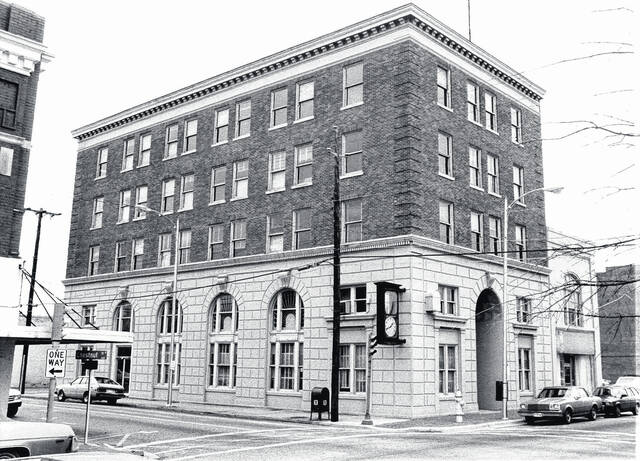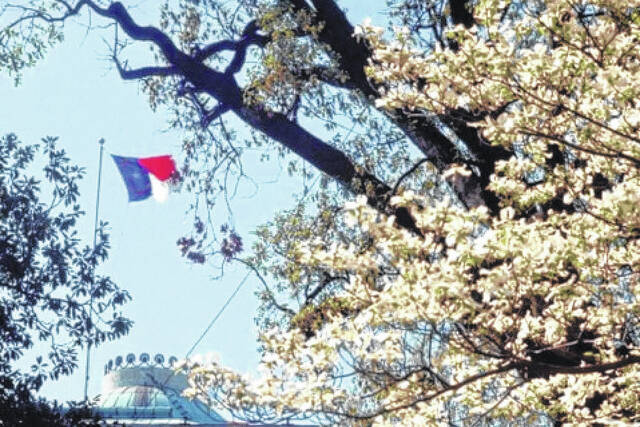
This photo taken in 1987 shows Lumberton’s “skyscraper” as reported in 1924. The Planters Building, listed on the National Register of Historic Places, stands at 312 N. Chestnut Street in downtown Lumberton.
THIS WEEK IN HISTORY
ROBESON COUNTY HISTORY
March 10: Skyscraper to be built in Lumberton by new firm. On March 10, 1924, The Robesonian stated, “Planters Building Corporation to erect a 5-story building for Planters Bank & Trust Co. — Electric elevator service — to cost about $100,000.” That headline appeared above the following: “Work on Lumberton’s first skyscraper will begin within the next few weeks, according to Mr. K.M. Barnes, president of the Planters Building corporation, which concern was recently granted a charter by W. N. Everett. secretary of state. … The cost of the building is estimated at approximately $100,000 and it will bea structure of which a town many times the size of Lumberton might well be proud.” The building stands at 312 N. Chestnut Street and is listed on the National Register of Historic Places.
March 10: Old Main Commission Accepts Revamp Plan. On March 10, 1974, The Robesonian reported, “PEMBROKE — The future of Old Main came one step closer to being decided here Friday night. Members of the Old Main Commission voted unanimously to accept plans proposed by Community Development Group in the School of Design at N.C. State. Old Main is the building on the campus of Pembroke State University [Now the University of North Carolina at Pembroke] which housed the first Indian college in America. Its destiny has been in question for the past two years, since university officials decided to raze the structure to construct a new building for university use.”
March 10: Company plans large solar farm near St. Pauls. On March 10, 2015, The Robesonian reported, “ ST. PAULS — A Texas-based Company, Principal Solar of Dallas, has plans to build a mammoth $154 million solar farm in the Gray’s Creek Township area of Cumberland County, just north of St. Pauls.
NORTH CAROLINA HISTORY
MARCH 9: Speaker Ban Law Challenged At UNC-Chapel Hill. On March 9, 1966, Herbert Aptheker attempted to speak to students near the Confederate monument at UNC-Chapel Hill. The campus police chief escorted him a short distance away to a spot technically off-campus. There, Aptheker, a historian and member of the Communist Party, spoke to 2,000 students from the sidewalk outside the rock wall that separates the campus from Franklin Street.
The speech came almost three years after the state legislature passed on June 26, 1963, “An Act to Regulate Visiting Speakers at State Supported Colleges and Universities,” otherwise known as the Speaker Ban law. The action came just weeks after students joined others in Raleigh to advocate civil rights. The Speaker Ban forbade from speaking at a state school any known Communist, anyone who advocated overthrow of the government, or anyone who exercised Fifth Amendment rights when questioned on related topics. Passage of the law came with very little debate on the last day of the legislative term.
Administrators, faculty and students loudly protested the infringement of First Amendment rights but it was not until 1968 that the law was declared unconstitutional.
In October 2011 a marker commemorating the actions of students to challenge the Speaker Ban law was dedicated on the spot where Aptheker’s speech took place.
MARCH 9: The Dougherty Brothers and Appalachian State University: On March 9, 1903, the General Assembly granted brothers B.B. and D.D. (short for Blanford Barnard and Dauphin Disco, respectively) Dougherty a charter for the Appalachian Training School for Teachers.
The school had its roots in the Doughertys’ Watauga Academy, which they established in 1899 to train public school teachers for jobs in western North Carolina. With both brothers at the helm, B. B. Dougherty was considered head of school, while D. D., was the principal.
D. D. served as the budding school’s business manager and head trustee until June 1929 when he died of a heart attack on the first day of registration. The original library on the campus is named in his honor.
B. B. remained president of the college until retirement in 1955, and he died two years later at age 87. During his nearly 60 years of service to the school, the Appalachian had grown from a small teaching college with a single two-year degree program to a regional center for higher education with four-year bachelor’s program and a graduate school.
Twelve years after B. B.’s retirement, the state legislature changed the school’s name to Appalachian State University. The campus has been a part of the UNC system since 1972.
MARCH 10: Kilpatrick’s “Shirt-Tail Skedaddle.” Kilpatrick in 1863On March 10, 1865, Confederate Gen. Wade Hampton surprised Union Gen. Hugh J. Kilpatrick at Monroe’s Crossroads. Kilpatrick’s 3rd Cavalry Division was protecting the left flank of Gen. William T. Sherman’s army as troops headed north.
On the night of March 9, Kilpatrick’s division camped at Monroe’s Crossroads, in what is now Hoke County. Confederate cavalrymen led by Hampton approached the camp from behind and found the rear of it completely defenseless. They retreated to plan a surprise attack.
The next morning, Kilpatrick woke up early and stepped outside of the house in his nightshirt. At that point, Confederate cavalrymen charged through the camp. Groggy Federal soldiers rose from their bedrolls, clumsily took their weapons and headed for shelter. Still only in his nightshirt, Kilpatrick ran across the yard in his bare feet, mounted a horse and escaped.
In just a few minutes the Confederates had overrun the camp. Union troops regained control when a lieutenant reached the unguarded Confederate artillery pieces and fired them into a mass of Confederates. By 9 a.m., the Confederates had retreated.
Today, the battlefield site is an artillery impact area at Fort Bragg. The gravestones of Union and Confederate soldiers who lost their lives that day are hidden throughout the woods.
MARCH 11: Convict Labor Constructed Swannanoa Tunnel. A train on the Western North Carolina Railroad in Jackson County. On March 11, 1879, the Western North Carolina Railroad’s Swannanoa Tunnel opened. The tunnel opened the mountain region to growth and freed it from its relative state of isolation.
Authorized by the General Assembly in 1855, construction of the tunnel was spurred by a drought in 1845. The drought resulted in a total crop failure on mountain farms. Pack trains and loaded wagons were unable to provide frontier families with enough food to carry them through to the next crop.
By the beginning of the Civil War, all but 70 miles of the route into Asheville was complete. During Reconstruction, the state secured $4 million in bonds for the completion of the project, but construction was delayed after key players embezzled some of the funds. It did not resume until 1877.
The General Assembly approved the use of 500 convicts as laborers, and 125 men lost their lives in the course of the work. Though the tunnel was cut through in March 1879, it wasn’t until October 1880 that the tracks were clear and the first train from Salisbury reached Asheville.
MARCH 11: End of Story for Confederate CSS Neuse: On March 11, 1865, the Confederate ironclad CSS Neuse was scuttled in the Neuse River, just downstream from Kinston, to prevent its capture by advancing Union forces. Following the Battle of Wyse Fork, fought the three days earlier, Gen. Braxton Bragg ordered the gunboat’s commander, Capt. Joseph Price, to use his vessel to hold off Union Gen. Jacob D. Cox’s force while the Confederate Army evacuated the town and retreated west toward Goldsboro. The ship was then to be destroyed.
The CSS Neuse had been partially constructed at what is now Seven Springs, starting in October 1862. It was floated downriver to Kinston in the summer of 1863, where it was outfitted with armor plating, engines and guns. The project was delayed numerous times, but the Neuse was launched in April 1864 and commanded to steam downriver to assist in an attempt to recapture Union-occupied New Bern.
Unfortunately, the ship ran aground and never made it downriver again until being called into action in March 1865. Following Gen. Bragg’s orders, once the evacuation of Kinston was complete, the crew of the Neuse set fire to the ship and left it to sink. By March 13, the crew was in Halifax awaiting their next assignment.
MARCH 12: Secret Basketball Game of 1944. On March 12, 1944, an all-white team from Duke University’s medical school faced off against an all-black team from what is now North Carolina Central University, the Eagles, in a secret, interracial basketball game.
At the time, strict segregation laws criminalized racial interaction and fostered a dangerous environment for those who violated them, prompting the participants to take extreme caution in planning and attending the event. Coaches kept school administrators in the dark and barred the doors to the Eagles’ gym.
The two teams played cautiously at first, worried that a foul might morph into a fight. But, by the second half, the jitters subsided, and the teams focused on just playing the game. When the clock ran down, the Eagles, who had lost only one game that season, emerged victorious. The final score was 88-44.
The two teams then mixed their squads and played a second game. One Duke player told his family “we sure had fun and I especially had a good time, for most of the fellows playing with me were Southerners… . And when the evening was over, most of them had changed their views quite a lot.”
March 14: Wildlife Preserve on the Alligator River: On March 14, 1984, the Alligator River National Wildlife Refuge was established on mainland Dare and Hyde counties to protect and preserve the forested wetland habitat called “pocosin” and its associated wildlife species.
In the late 1970s, biologists were growing concerned by the rapid loss of wetlands in eastern North Carolina as pocosins were drained and old-growth cypress and Atlantic white cedar trees were destroyed for logging and farming operations. Several conservation organizations and state and federal agencies worked together to preserve these fragile wetlands.
The Prudential Life Insurance Company donated the refuge’s first 118,000 acres, and congressional appropriations eventually allowed it to expand to the more than 150,000 acres it covers today. The preserved area is bordered by the Alligator River and Intracoastal Waterway; Albemarle Sound; Croatan and Pamlico sounds; and the Long Shoal River and corporate farmlands.
In 1986, the U.S. Fish and Wildlife Service initiated the Red Wolf Recovery Program to reestablish the endangered red wolf population in the wild. Today, about 100 red wolves roam the refuge. It is also an important habitat for black bear, American alligators, river otters and the endangered red-cockaded woodpecker. Two hundred species of birds have been recorded in the refuge.
The Fish and Wildlife Service has also launched a number of projects designed to restore habitat and monitor wildlife populations, including restoring historic water levels, banding wood ducks on the refuge and replanting Atlantic white cedars.
The refuge is open to the public year-round for hiking, kayaking, photography, birding, fishing and hunting in season.
March 15: Blossom of Dogwood Tree Official State Flower. On March 15, 1941, the General Assembly designated the dogwood as the state flower. In choosing the dogwood the General Assembly called the bloom “a radiantly beautiful flower which grows abundantly in all parts of this State.”
Four species of dogwood are native to North Carolina. Cornus florida, the flowering dogwood, grows on a tree, and can be found during spring in most parts of the state, and is the flower with which most people are familiar.
Cornus racemose, the grey dogwood, grows on a bush can and be found in the northern Piedmont, and Cornus asperifolia, the roughleaf dogwood, is found along the southeast coast.
The alternate-leaf dogwood, Cornus alternifolia, was once found in the Piedmont, but now can only be seen in the mountains.
The dogwood is both the official state tree and flower of Virginia, and the state tree of Missouri.
NATION AND WORLD HISTORY
March 9: New Deal Legislation. On March 9, 1933, Congress, called into special session by President Franklin D. Roosevelt, began its “hundred days” of enacting New Deal legislation.
MARCH 10: First words spoken over phone. In 1876, Alexander Graham Bell’s assistant, Thomas Watson, heard Bell say over his experimental telephone: “Mr. Watson — come here — I want to see you” from the next room of Bell’s Boston laboratory.
March 11: Massive earthquake and tsunami in Japan kill nearly 20,000. On March 11, 2011, a magnitude-9.0 earthquake and resulting tsunami struck Japan’s northeastern coast, killing nearly 20,000 people and severely damaging the Fukushima Dai-ichi nuclear power station.
March 12: Jazz legend Charlie ‘Bird’ Parker dies at 34. On March 12, 1955, legendary jazz saxophonist Charlie “Bird” Parker died in New York at age 34.
March 13: Jorge Bergoglio of Argentina becomes Pope Francis. On March 13, 2013, Jorge Bergoglio of Argentina was elected pope, choosing the name Francis. he was the first pontiff from the Americas and the first from outside Europe in more than a millennium.
March 14: Albert is Einstein is born and Stephen Hawking dies. On March 14, 1879, Albert Einstein, who would revolutionize physics and the human understanding of the universe, was born in Ulm, Germany.
March 15: Julius Caesar is assassinated. On March 15, 44 B.C., Roman dictator Julius Caesar was assassinated by a group of nobles that included Brutus and Cassius.
March 16: US soldiers kill hundreds of unarmed Vietnamese in My Lai massacre. On March 16, 1968, the My Lai (mee ly) massacre took place during the Vietnam War as U.S. Army soldiers hunting for Viet Cong fighters and sympathizers killed unarmed villagers in two hamlets of Son My (suhn mee) village; estimates of the death toll vary from 347 to 504.
This Week In History is compiled by Executive Editor David Kennard from Robesonian archives, the North Carolina Department of Natural and Cultural Resources and the Associated Press.









